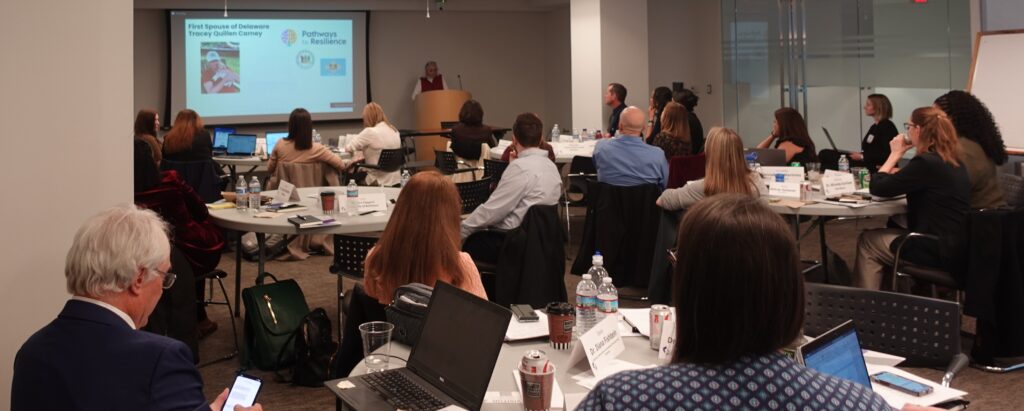The National Governors Association (NGA) welcomed state teams from New Mexico and West Virginia to Washington, D.C., February 15-16. These teams have been selected to work with NGA over six months on projects that strengthen state responses to Substance Use Disorder (SUD) through a trauma-informed policy and practice lens. NGA is leveraging the expertise of the National Prevention Science Coalition (NPSC) to support state projects. Members of the State Trauma and Resilience Network (STRN) from Pennsylvania, Maryland, New Jersey and Virginia also joined the meeting. The STRN is a group of Governors’ advisors and senior state leaders who work to address adverse childhood experiences (ACEs), trauma and resiliency in their states.
The event featured subject matter experts discussing science, prevention and policy related to the intersection of trauma and SUD. Dr. Carrie Mulford of the National Institute on Drug Abuse and Captain Christopher Jones, Director of SAMHSA’s Center for Substance Abuse and Prevention, presented a foundation for understanding the scientific link between trauma and substance use disorder. While individual reactions to trauma vary widely, a history of trauma increases an individual’s risk of substance use and the development of SUD. The experience of trauma is extremely common, with 7 out of 10 people in the U.S. experiencing at least one traumatic event in their lifetime. While responses to trauma vary widely, most people are resilient and only a small percentage develop long-term trauma disorders. However, trauma–particularly long-term trauma disorder–is related to substance use and associated with the development of SUD, and three out of four people who have SUD have experienced trauma.
Trauma experiences do not happen in a vacuum, and there are many factors at the individual, interpersonal, community and societal level that can exacerbate or attenuate the risk relationship between trauma and SUD. These factors make up the context and complex risk environment in which Adverse Childhood Experiences (ACEs) and trauma occur. The behavioral and biological changes resulting from trauma accumulate over time and have long-term consequences for emotional functioning, regulatory capacities, physical health and successful performance in a variety of domains, including education, parenting and employment. As a result, people with substance use disorders need and use many services and supports in addition to behavioral health.
Speakers Dr. Lora Peppard with the Washington/Baltimore High Intensity Drug Trafficking Area (HIDTA) and Dr. Christina Bethell of Johns Hopkins University described the role of prevention science in addressing the link between trauma and addiction, along with the role of screening, assessment and referral. Programs and policies that take a broad view of prevention, strengthening protective factors, promoting positive childhood experiences and supporting families, can prevent the occurrence of adverse experiences in children and have multi-generational benefits. Successful prevention programs and policies are thoughtful, evidence-based, sufficiently funded and grounded in a comprehensive strategy. Dr. Bethell highlighted the Engagement in Action (EnAct!) Framework, which promotes health equity for children and families.
Delaware First Lady Tracey Quillen Carney delivered plenary remarks, sharing her personal commitment to supporting her state’s families and children as well as information about First Chance Delaware, a framework promoting a culture of commitment to Delaware’s children. Dr. Cherie Rooks-Peck, Branch Chief of Prevention Programs and Evaluation in CDC’s Division of Overdose Prevention, shared an overview of the national trends in overdose prevention, highlighting CDC’s approach, along with resources and training opportunities for states to prevent overdose and ACEs.

Presenters also discussed evidence-based approaches to treating trauma disorders, including those that co-occur with SUD. Dr. Carrie Wilkens of the Center for Motivation & Change explained how internalized stigma, along with external challenges, prevent people from seeking and receiving treatment. Dr. Keith Humphreys of Stanford University noted policy strategies, evidence-based programs and funding opportunities for states to integrate trauma-informed responses into SUD treatment, with emphasis on opportunities in the criminal legal system. The first day of the meeting closed with a discussion of state and local successes, with Laurie Crawford, Director of the Office of Trauma and Resilience Policy in Virginia, moderating a discussion with the following leaders of state initiatives: Dr. Mandy Davis of Trauma Informed Oregon, Chidi Jenkins of Ascend at the Aspen Institute and Craig PoVey of JBS International.
During the second day of the convening, NGA staff led West Virginia and New Mexico teams through a facilitated process to identify their project goals and action steps. The New Mexico state team will be working to support SUD treatment for parents whose children are at risk for involvement with the Children, Youth, and Families Department. The West Virginia team plans to assess current practices and trauma-informed care training needs among SUD providers, develop an education initiative to promote positive messaging over Adverse Childhood Experiences and pilot a form of trauma-informed therapy at two sites. The NGA Center for Best Practices will be supporting state teams as they undertake this important work.












